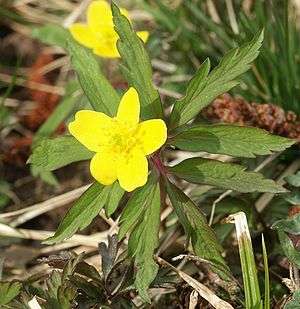Anemone
< Horticulture| Anemone | |
|---|---|
 | |
| Genus: | Anemone |
| Family: | Ranunculaceae |
| Pollination: | Insects |
| Toxicity and edibility: | Toxic if ingested, sap may irritate the skin. |
Anemone (Anemone) (from the Greek Άνεμος, wind), is a genus of about 120 species of flowering plants in the buttercup family Ranunculaceae in the north and south temperate zones. They are closely related to Pasque flower (Pulsatilla) and Hepatica (Hepatica); some botanists include both of these genera within Anemone.
The meaning of the anemone flower is "forsaken" and also "a dying hope". The flower Anemone could also be used to signify Anticipation.
The Anemone coronaria ("Kalanit" in Hebrew) is one of the most well known and beloved flowers in Israel. During the British Mandate of Palestine British soldiers were nicknamed "Kalaniyot" for their red berrets.
Description
The plants are perennial herbs with an underground rootstock, and radical, more or less deeply cut leaves. The elongated flower stem bears one or several, white, red, blue or rarely yellow, flowers; there is an involucre of three leaflets below each flower. The fruits often bear long hairy styles which aid their distribution by the wind ("windflower" is a common name sometimes used for members of the genus). Stems are hairy, with an acrid sap.
Growing Conditions
They grow best in a loamy soil, enriched with well-rotted manure, which should be dug in below the tubers. These may be planted in October, and for succession in January, the autumn-planted ones being protected by a covering of leaves or short stable litter. They will flower in May and June, and when the leaves have ripened should be taken up into a dry room till planting time. They are easily raised from the seed, and a bed of the single varieties is a valuable addition to a flower-garden, as it affords, in a warm situation, an abundance of handsome and often brilliant spring flowers, almost as early as the snowdrop or crocus.
Uses
Many of the species are favourite garden plants; among the best known is Anemone coronaria, often called the poppy anemone, a tuberous-rooted plant, with parsley-like divided leaves, and large showy poppy-like blossoms on stalks of from 15–20 cm high; the flowers are of various colours, but the principal are scarlet, crimson, blue, purple and white. There are also double-flowered varieties, in which the stamens in the centre are replaced by a tuft of narrow petals. It is an old garden favourite, and of the double forms there are named varieties.
The genus contains many other spring-flowering plants, of which A. hortensis and A. fulgens have less divided leaves and splendid rosy-purple or scarlet flowers; they require similar treatment. Anemone hupehensis, and its white cultivar 'Honorine Joubert', the latter especially, are amongst the finest of autumn-flowering hardy perennials; they grow well in light soil, and reach 60–100 cm in height, blooming continually for several weeks. A group of dwarf species, represented by the native British A. nemorosa and A. apennina, are amongst the most beautiful of spring flowers for planting in woods and shady places.
Pests and Diseases
- Cercospora pulsatillae
- Cercosporella filiformis
- Didymaria didyma
- Phyllosticta anemones
- Phyllosticta anemonicola
- Ramularia ranunculi
- Septoria anemones
- Septoria punicea
Flower Spot and Distortion, Leaf Gall
- Synchytrium anemones
Downy Mildews
- Plasmopara pygmaea
Rhizome or Root Rots
- Pellicularia rolfsii
- Sclerotium delphinii
Collar or Crown Rots
- Botrytis cinerea
- Puccinia recondita var. agropyri
- Tranzschelia cohaesa
- Tranzschelia fusca
- Tranzschelia pruni-spinosae (Alternate hosts in Prunus)
- Tranzschelia suffusca
- Tranzschelia tusconensis
Smuts
- Urocystis anemones
Viri
- Mosaic
- Aphelenchoides olesistus: Fern Nematode
- Ditylenchus dispaci: Stem and Bulb Nematode
- Ornate Aphid: Myzus ornatus
- Green Peach Aphid: Myzus persicae
- Foxglove Aphid: Acyrthosiphon solani
- Ground Mealybug: Rhizocecus falcifer
- Black Blister Beetle: Epicuata pennsylvanica
Flea Beetles
- Cutworms: Agrotis spp.
- Greenhous Leaftier: Udea rubigalis
- w:Angle Shades
- w:Heart and Dart
Slugs and Snails
References
- Encyclopedia Britannica, Eleventh Edition.
- Britton, Nathaniel Lord; Addison Brown (1913). An Illustrated Flora of the Northern United States and Canada, Volume 2 (second edition ed.). Dover Publications, inc.. pp. 97-100.
- Ann Fowler Rhoads and Timothy A. Block (2000). The Plants of Pennsylvania: An Illustrated Manual. Anna Anisko, illustrator. Morris Arboretum, University of Pennsylvania Press. pp. 569-571.
- P. D. Strausbaugh and Earl L. Core (1977). Flora of West Virginia (Second ed.). Seneca Books, Grantsville, W. Virginia. pp. 390-392.
- Christopher Brickell and Judith D. Zuk (1997). The American Horticultural Society A-Z Encyclopedia of Garden Plants. DK Publishing. pp. 114-117.
- Staff of the L. H. Bailey Hortorium (1976). Hortus Third: A Concise Dictionary of Plants Cultivated in the United States and Canada. Cornell University Press. pp. 75-77.
- Pirone, Pascal P. (1978). Diseases & Pests of Ornamental Plants (Fifth Edition ed.). John Wiley & Sons, New York. pp. 135-136.
- Cranshaw, Whitney (2004). Garden Insects of North America: The Ultimate Guide to Backyard Bugs. Princeton University Press. pp. 579.